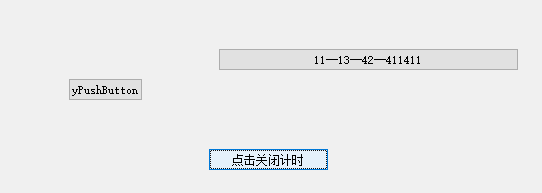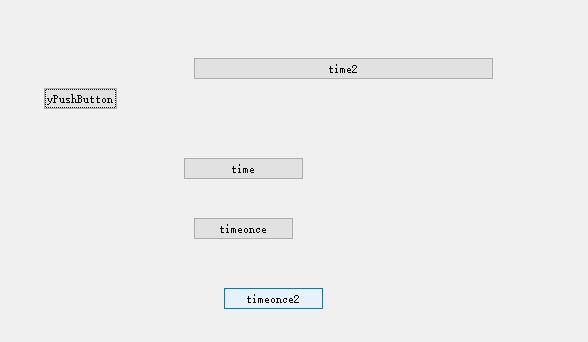qt定时器类QTimer
qt定时器类QTimer
- API
- 信号
- 例子
- static public function
使用方式:创建一个QTimer类对象,然后调用其 start() 函数开启定时器,此后QTimer对象就会周期性的发出 timeout() 信号。
API
// 构造函数
// 如果指定了父对象, 创建的堆内存可以自动析构
QTimer::QTimer(QObject *parent = nullptr);
// 设置定时器时间间隔为 msec 毫秒
// 默认值是0,一旦窗口系统事件队列中的所有事件都已经被处理完,一个时间间隔为0的QTimer就会触发
void QTimer::setInterval(int msec);
// 获取定时器的时间间隔, 返回值单位: 毫秒
int QTimer::interval() const;
// 根据指定的时间间隔启动或者重启定时器, 需要调用 setInterval() 设置时间间隔
[slot] void QTimer::start();
// 启动或重新启动定时器,超时间隔为msec毫秒。
[slot] void QTimer::start(int msec);
// 停止定时器。
[slot] void QTimer::stop();
// 设置定时器精度
/*
参数:
- Qt::PreciseTimer -> 精确的精度, 毫秒级
- Qt::CoarseTimer -> 粗糙的精度, 和1毫秒的误差在5%的范围内, 默认精度
- Qt::VeryCoarseTimer -> 非常粗糙的精度, 精度在1秒左右
*/
void QTimer::setTimerType(Qt::TimerType atype);
Qt::TimerType QTimer::timerType() const; // 获取当前定时器的精度
// 如果定时器正在运行,返回true; 否则返回false。
bool QTimer::isActive() const;
// 判断定时器是否只触发一次
bool QTimer::isSingleShot() const;
// 设置定时器是否只触发一次, 参数为true定时器只触发一次, 为false定时器重复触发, 默认为false
void QTimer::setSingleShot(bool singleShot);
信号
这个类的信号只有一个, 当定时器超时时,该信号就会被发射出来。给这个信号通过conect()关联一个槽函数, 就可以在槽函数中处理超时事件了。
[signal] void QTimer::timeout();
// 启动或重新启动定时器,超时间隔为msec毫秒
[slot] void QTimer::start(int msec);
//如果不指定,可以调用:
void QTimer::setInterval(int msec);
当时间超时,就会发射QTimer::timeout();信号。
例子
周期性定时器
#include "mainwindow.h"
#include "ui_mainwindow.h"
#include "QDebug"
#include "QTimer"
#include "QTime"
MainWindow::MainWindow(QWidget *parent)
: QMainWindow(parent)
, ui(new Ui::MainWindow)
{
ui->setupUi(this);
tom = new me(this);
myteacher = new teacher(this);
QTimer* timer = new QTimer(this);
timer->setTimerType(Qt::PreciseTimer);
connect(ui->myPushButton1,&QPushButton::clicked,this,[=](){
qDebug() <<"调用一次";
tom->sendMsg();
});
connect(tom,&me::sendMsg,myteacher,&teacher::receiveMsg);
//timer
connect(ui->time,&QPushButton::clicked,this,[=](){
//qDebug() <<"调用一次";
if(timer->isActive()){
timer->stop();
ui->time->setText("点击开始计时");
}else{
timer->start(1000);
ui->time->setText("点击关闭计时");
}
});
//当定时间超时,调用槽函数
connect(timer,&QTimer::timeout,this,[=](){
QTime time = QTime::currentTime();
QString timestr = time.toString("hh--mm--ss--zz");
ui->time2->setText(timestr);
});
}
MainWindow::~MainWindow()
{
delete ui;
}
一次性定时器
点击一次,当时间超时,只发送一次timeout信号
//一次性定时器
QTimer* timerone = new QTimer(this);
timerone->setTimerType(Qt::PreciseTimer);
timerone->setSingleShot(true);//一次性
connect(ui->timeonce,&QPushButton::clicked,this,[=](){
qDebug() <<"调用一次";
if(timerone->isActive()){
timerone->stop();
ui->timeonce->setText("点击开始计时");
}else{
timerone->start(1000);
ui->timeonce->setText("点击关闭计时");
}
});
//当定时间超时,调用槽函数
connect(timerone,&QTimer::timeout,this,[=](){
QTime time = QTime::currentTime();
QString timestr = time.toString("hh--mm--ss--zz");
ui->time2->setText(timestr);
});


点击一次,时间超时,触发超时信号,槽函数显示当前时间(由于超时信号只发送一次,时间变化一次后,之后就不变化了)
再点击一次:

又更新一次。
static public function
/*
功能: 在msec毫秒后发射一次信号, 并且只发射一次
参数:
- msec: 在msec毫秒后发射信号
- receiver: 接收信号的对象地址
- method: 槽函数地址
*/
[static] void QTimer::singleShot(
int msec, const QObject *receiver,
PointerToMemberFunction method);
//一次性定时器 (使用[static] void QTimer::singleShot)
// [static] void QTimer::singleShot(
// int msec, const QObject *receiver,
// PointerToMemberFunction method);
// 参数:
// - msec: 在msec毫秒后发射信号
// - receiver: 接收信号的对象地址
// - method: 槽函数地址
connect(ui->timeonce2,&QPushButton::clicked,this,[=](){
// 获取2s以后的系统时间, 不创建定时器对象, 直接使用类的静态方法
QTimer::singleShot(2000,this,[=](){
QTime tm = QTime::currentTime();
// 格式化当前得到的系统时间
QString tmstr = tm.toString("hh:mm:ss.zzz");
// 设置要显示的时间
ui->time2->setText(tmstr);
});
});





